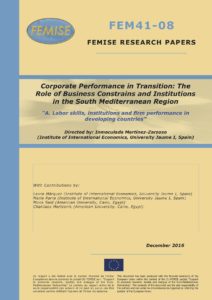Summary :
Note: The research project comprises three papers:
Paper 1. Labor skills, institutions and firm performance in developing countries
Paper 2. Business environmental constraints in MENA countries with a special focus on Egypt
Paper 3. Exports and governance: Is MENA different?

This report aims at analyzing the recent trends in corporate performance and economic success in Southern Mediterranean countries at the firm and country level. More specifically, it aims at identifying and evaluating the potential factors that may trigger and foster economic changes in the region, focusing in particular on the role played by skill constraints, the business environment and the institutional setting in explaining economic performance, measured as productivity, sales growth rates and exports, as well as quantifying their relative importance. Firstly, we investigate different sources of economic performance steaming from factors that are internal and external to the firm. At the firm level, the business environment encompasses features relative to the work force, legal, regulatory, financial, and institutional system of a country and therefore it has an impact on the performance of firms and industries.
Secondly, since the business environment affects firms and country performance, then we proceed with an empirical investigation at the country level as well. The common underlying assumption is that firms and countries facing ‘better’ business environments and institutions can be expected to perform better.
The main novelty of this report is to produce empirical evidence covering the transition period on the conditions that influence private sector performance and country level exports in the South Mediterranean region in comparison to other regions/countries that also went through an economic and institutional transition in the past. As a result, the study provides the tools for designing appropriate development policies.
This report is structured into three parts: the first part focuses on skills and resource characteristics of firms and the role of the main perceived constrains to do business at the firm level. Micro survey data is used to explore the impact of labor skills and other firm-specific characteristics on firm performance, measured as sales growth rates, in 135 developing countries. The analysis uses a consistent and large data set from the World Bank’s Enterprise Surveys. The results show that labor skills and firm-specific characteristics are significant predictors of firms’ performance. However, the predictive power of labor skills and the firm-specific characteristics is significantly affected by national economic and non-economic factors. Indeed, the national levels of economic, financial and human development as well as income inequality, along with domestic conditions of regulatory governance and other institutions as well as legal and social heterogeneity, all have a role to play in determining firms’ performance. The results show that the classification of firms as labor skill-constrained or not in developing countries can be better assessed on the basis of both micro-level and macro-level factors.
The second part of the report specifically focuses on the main obstacles that MENA firms, and in particular Egyptian enterprises, face to do business in their country and investigates to what extent the constraints affect firm performance. Firm’s performance is measured as Total Factor Productivity (TFP) and labour productivity (LP). Our analysis evaluates the effects of the different business indicators, obtained from the World Bank Enterprise Survey using firm level data from manufacturing firms, on TFP/LP. A number of control variables commonly used in the empirical literature are also included in the model. The main results indicate that access and cost to finance, tax rates, regulatory policy uncertainty, the price of land and basic infrastructures, such as access to water and electricity, are among the most relevant factors for Egypt. These findings have important policy implications, in particular for policy makers and will help them decide what sort of specific actions can be taken to reduce the main obstacles and consequently to pave the way for manufacturing Egyptian firms to become more competitive. The analysis is also extended to other countries in the region, namely Lebanon, Jordan, Morocco and Tunisia and the environmental constrains before and after the Arab Spring are compared. The main findings indicate that regulatory and policy uncertainty, corruption and crime have become more important obstacles after 2011 for most firms in these countries.
The third part focuses on the country-level analysis and investigates the role of the quality of institutions and its different dimensions in the selected countries in explaining export performance. It aims at analysing whether higher quality of economic governance rewards economy performance and facilitates the integration of the MENA region in the world economy. A gravity model of trade augmented with governance indicators is estimated using bilateral exports among 189 trading partners and also for 19 MENA exporters over the period from 1996 to 2013. The main results show that, individually, each of the six governance indicators in the exporting and the importing countries considered has a positive effect on bilateral trade. However, the results for MENA exporters slightly differ. Governance in the importing countries seems to be less relevant for MENA exporters than for the rest of exporters. The effect of country pair similarity in governance indicators indicate similar levels of regulatory quality and the rule of law in exporter and importer countries favours exports of MENA countries. Similarities in voice and accountability also foster exports in the average exporter, but it does not seem relevant for MENA exporters.


